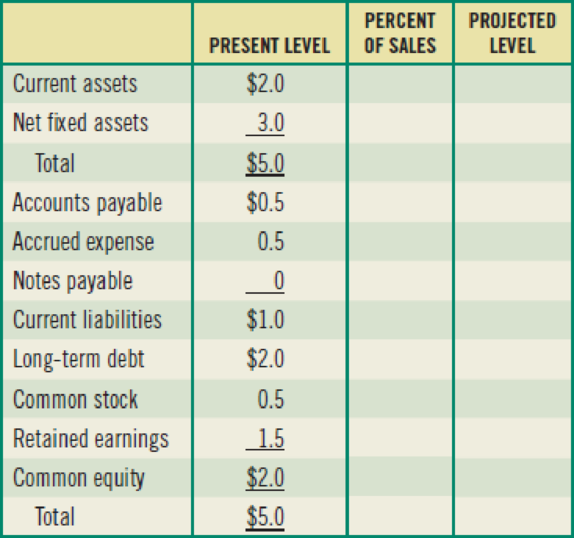
Concept explainers
(Financial forecasting—discretionary financing needs) The most recent balance sheet for the Armadillo Dog Biscuit Co., Inc. is shown in the corresponding table. The company is about to embark on an advertising campaign, which is expected to raise sales from the current level of $5 million to $7 million by the end of next year. The firm is currently operating at full capacity and will have to increase its investment in both current and fixed assets to support the projected level of new sales. In fact, the firm estimates that both categories of assets will rise in direct proportion to the projected increase in sales.
Armadillo Dog Biscuit Co. Inc., ($ Millions)

The firm’s net profits were 6 percent of the current year’s sales but are expected to rise to 7 percent of next year’s sales. To help support its anticipated growth in asset needs next year, the firm has suspended plans to pay cash dividends to its stockholders. In past years a $1.50-per-share dividend has been paid annually. Armadillo’s accounts payable and accrued expenses are expected to vary directly with sales. In addition, notes payable will be used to supply the funds needed to finance next year’s operations that are not forthcoming from other sources.
- a. Fill in the table and project the firm’s needs for discretionary financing. Use notes payable as the balancing entry for future discretionary financing needs.
- b. Compare Armadillo’s current ratio (current assets/current liabilities) and debt ratio (total liabilities/total assets) before the growth in sales and after. What was the effect of the expanded sales on these two dimensions of Armadillo’s financial condition?
- c. What difference, if any, would have resulted if Armadillo’s sales had risen to $6 million in 1 year and $7 million only after 2 years? Discuss only; no calculations are required.
Want to see the full answer?
Check out a sample textbook solution
Chapter 14 Solutions
EBK FOUNDATIONS OF FINANCE
- 19. A company’s weighted average cost of capital (WACC) includes:A. Only equityB. Only debtC. Both equity and debtD. Only retained earnings need helparrow_forwardA company’s weighted average cost of capital (WACC) includes:A. Only equityB. Only debtC. Both equity and debtD. Only retained earningsarrow_forwardNo AI A company’s weighted average cost of capital (WACC) includes:A. Only equityB. Only debtC. Both equity and debtD. Only retained earningsarrow_forward
- A stock split usually results in:A. Higher stock priceB. Lower number of outstanding sharesC. Increased total market valueD. Lower stock price but same market capitalizationarrow_forwardA stock split usually results in:A. Higher stock priceB. Lower number of outstanding sharesC. Increased total market valueD. Lower stock price but same market capitalization need helparrow_forwardNo AI Which of the following is not a component of working capital?A. InventoryB. Accounts PayableC. Long-term DebtD. Casharrow_forward
- Which of the following is not a component of working capital?A. InventoryB. Accounts PayableC. Long-term DebtD. Casharrow_forwardI need help Which of the following is a capital budgeting technique? A. Payback PeriodB. Current RatioC. Debt-to-Equity RatioD. Acid-Test Ratioarrow_forwardCorrect answer Which of the following is a capital budgeting technique? A. Payback PeriodB. Current RatioC. Debt-to-Equity RatioD. Acid-Test Ratio answerarrow_forward
 EBK CONTEMPORARY FINANCIAL MANAGEMENTFinanceISBN:9781337514835Author:MOYERPublisher:CENGAGE LEARNING - CONSIGNMENTPrinciples of Accounting Volume 2AccountingISBN:9781947172609Author:OpenStaxPublisher:OpenStax College
EBK CONTEMPORARY FINANCIAL MANAGEMENTFinanceISBN:9781337514835Author:MOYERPublisher:CENGAGE LEARNING - CONSIGNMENTPrinciples of Accounting Volume 2AccountingISBN:9781947172609Author:OpenStaxPublisher:OpenStax College

